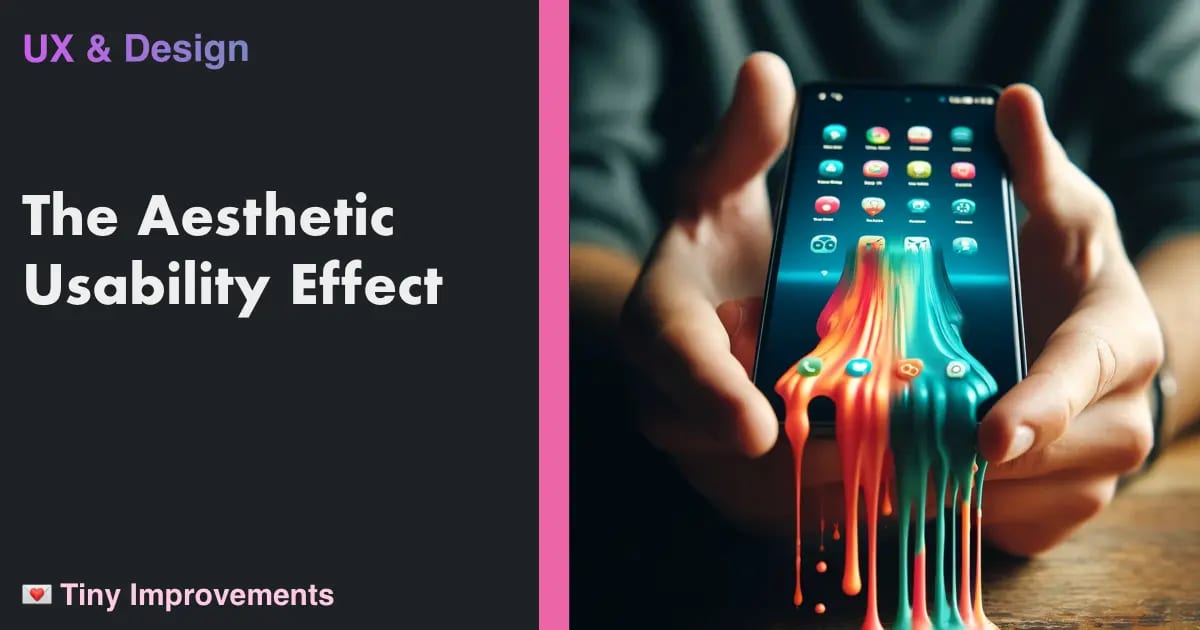
When building something new, what's more important: that it works, or that it looks good?
That's the hypothetical that was asked recently by a startup cofounder and CTO u/FormalFuel6425 on the Y Combinator subreddit. It's a great question, and one that has been asked many times before.
My take? If you want to build a successful product, you need to do both reasonably well, and design needs to be a priority from the start.
The Aesthetic-Usability Effect
The Aesthetic-Usability Effect is a psychological phenomenon where users perceive more aesthetically pleasing designs as easier to use than less aesthetically pleasing designs. More on Wikipedia.
This means that if your app isn't designed well, users will perceive it as harder to use than a more visually appealing app, even if the functionality is identical.
Read that again - and let it sink in a bit: the exact same app can be perceived as harder to use (and thus less valuable) if it's ugly.
As a bit of a contrived example, which of these two ChatGPTs would you rather use?


These are screenshots of the same ChatGPT session, with just three design changes between the two.
Which one do you trust more? Which one would you rather use?
Post.news vs Threads
The presentation you choose for your product can have a huge impact on how users feel about it initially. If you're building a new product, it's worth investing in design work early on to make sure your app is as visually appealing as possible.
It's rarely the case that we can point to design as the only reason something isn't successful, but it can certainly be a contributing factor.
A recent example that stands out in my mind: over the past couple years, there has been hot competition for a social network that can compete with Twitter. Two front-runners which stood out early on were Threads and Post.news. Here's a quick side-by-side:

Would it surprise you to hear that Post.news has since shut down?
This isn't entirely a fair comparison, of course - Threads has a huge network effect advantage by being tied to Instagram's user graph. But it's hard to ignore the fact that Threads has a much more polished aesthetic than Post.news.
I bounced off of Post almost immediately; the newspaper-inspired, serif-forward design felt dated and incomplete.
The other way around: design work buys you patience with early users
In practice, what this means is that if you're building a new product, you're setting yourself up for failure if the goal is just to make it work. You need to make it look good, too.
A product that looks and feels great (or at least good) will attract more people, will keep them around longer, and will make them more likely to forgive you when something goes wrong.
I like to think of it this way: putting time and effort into designing your app's UX shows that you care about the people using your app. It's a gesture that says "Your time and attention is valuable, and I want to make sure you feel at home here."
Frameworks are your friend
You don't need to reinvent the wheel. 99% of the time, you should be borrowing interaction patterns from website and apps that you're already familiar with. The work required to create is largely already done for you, and you should be taking advantage of the work that others have done to make your app feel familiar and comfortable.
To that end, there's loads of great UI frameworks that will save you time, and can help you get started with something that isn't complete garbage out of the box. If you're looking for a web framework to use, check out Tailwind UI, shadcn/ui, and Material UI are all great options.
If you're lucky enough to be able to hire a full-time designer one day, starting with these frameworks should make it easier to transition to a custom-branded design language later on.
Design or functionality? Both.
Going back to the original question: what's more important, that it works, or that it looks good? The answer is both.
Your thing needs to work on some fundamental level, and you should take care to make sure that it looks good and feels familiar to your users.
The frustrating thing about being thoughtful about design is that if you do a good job of it, the people using your software may not even notice. But whether consciously or subconsciously, they'll notice if you don't do some design work up front, and that's a problem.
More articles on design
A few years ago, I gave a talk on design with my pals Andrew Miller and Jeremy Osborn, called Your App Is Ugly. It is the reason why I spend so much time trying to get developers to invest in design education.
If you liked this newsletter, you may also appreciate these past dispatches, which tackle design from a few other angles:
- Become Unreasonable: Designing for Hospitality
- UX For Devs: Understanding Gestalt
- The finicky nature of color in product design
Everyone is a designer
I'm a big believer that everyone is a designer, and that everyone can learn to be a better designer. I keep a list of great design books I've read over on hardcover that you're welcome to peruse - check out The Designer's Reading List if you're looking for some more juicy reads from people way smarter than me.




